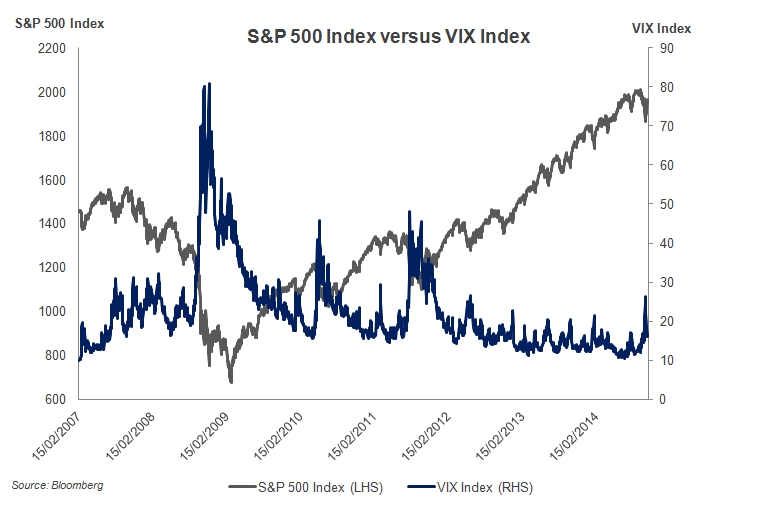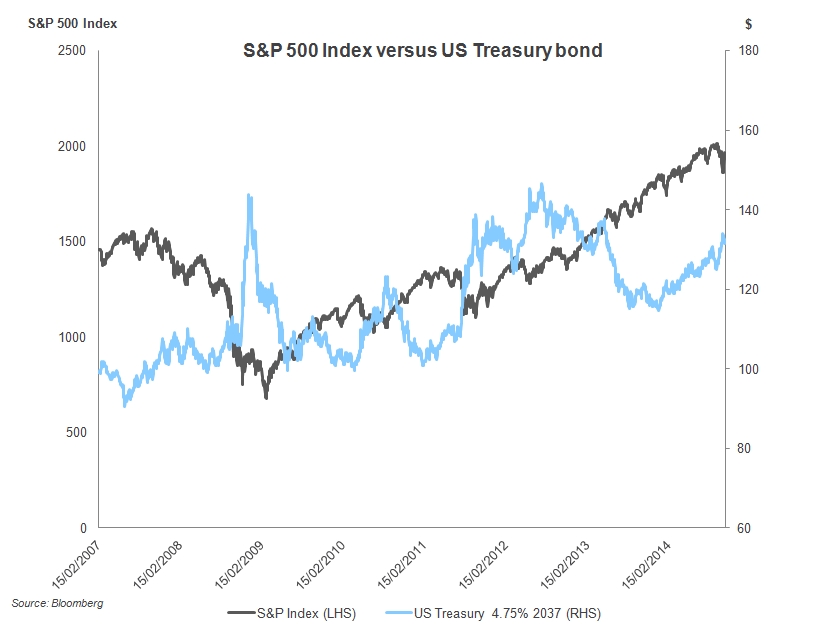by
Justin McCarthy | Oct 28, 2014
Volatility is an indication of risk. The more volatile the price (or return), the greater the perceived risk. This simple relationship is largely behind the fact that bonds are less risky than shares. Volatility in returns is one of the key differences between the two asset classes and (spoiler alert) therein lies the answer to protecting your portfolio again excessive volatility.
What is the VIX or so-called “fear index”
There is a strong connection between fear and volatility. It is often said that greed builds slowly whereas fear acts fast and with large, violent moves. Volatility is greatest in uncertain times. .
So the question for investors is how do we objectively measure volatility and how can we protect investment portfolios against it?
The most widely used and quoted measure of volatility is the VIX index. Given the relationship between volatility and fear it is also commonly referred to as the “fear index”.
VIX is the ticker symbol for the Chicago Board Options Exchange Market Volatility Index. It measures the level of implied equity volatility with reference to options on the US S&P 500 Stock Index. It is a real-time measure which provides crucial data to investors on the psyche of the market.
While the technical calculation methodology is a little complicated, the important point is that volatility is correlated to equity market moves. Behaviour is very different when equity markets are improving compared to when equity markets are declining. In general, most rises are slow and small, while most falls are quick and large (i.e. volatile).
In simple terms, we look to the VIX to tell us when uncertainty, risk, and even fear is increasing.
When the market expects declines in equities, the VIX rises, and rises dramatically. As the chart below demonstrates, increases in the VIX (dark blue line) are generally associated with declines in equities (as represented by the US S&P 500 index in grey). This was most stark in the GFC.

However, there is also a relationship between bonds, equities and the VIX. Typically periods of uncertainty see a flight to quality from equities to bonds. Notice in the chart below how the price of the bonds (as represented by US Treasury 2037s in light blue) increases when the VIX increases and equities decline.

How to protect your portfolio against volatility (and falling equities)
It is the countercyclical mechanism of fixed rate bonds that provides the answer to protecting against volatility and in particular declining values from the equity portion of your portfolio.
Depending on your risk appetite and ability to withstand volatility, an allocation to bonds (particularly fixed rate bonds) will greatly reduce the overall volatility of your investment portfolio.
While we have used US data in the above, the exact same relationship occurs in Australia.
The following checklist is a useful tool for all investors. Typically speaking, a spike in the VIX will see the following trends occurring in other markets:
- Low risk appetite (“risk-off”) and a flight to quality
- Falling equities
- Reduction in yields (i.e. the benchmark risk free Government bond yield and swap rates)
- Increase in values of fixed rate bonds, particularly long dated bonds
- Increase in credit spreads (which is often offset by the fall in benchmark swap rates/yield curves for fixed rate bonds)
- Underperformance of floating rate notes versus fixed rate bonds given that FRNs are impacted by higher credit spreads but also see falling base rates such as the bank bill swap rate (BBSW)
- A reduction in liquidity and wider bid-offer spreads
All investors should regularly assess their portfolios to ensure they match their individual circumstances. Volatility is an important measure to consider in long term planning but also to monitor for assessing current market trends and potential changes to your portfolio, with the VIX being the most recognised volatility measure.
Copyright The contents of this document are copyright. Other than under the Copyright Act 1968 (Cth), no part of it may be reproduced or distributed to a third party without FIIG’s prior written permission other than to the recipient’s accountants, tax advisors and lawyers for the purpose of the recipient obtaining advice prior to making any investment decision. FIIG asserts all of its intellectual property rights in relation to this document and reserves its rights to prosecute for breaches of those rights.
Disclaimer Certain statements contained in the information may be statements of future expectations and other forward-looking statements. These statements involve subjective judgement and analysis and may be based on third party sources and are subject to significant known and unknown uncertainties, risks and contingencies outside the control of the company which may cause actual results to vary materially from those expressed or implied by these forward looking statements. Forward-looking statements contained in the information regarding past trends or activities should not be taken as a representation that such trends or activities will continue in the future. You should not place undue reliance on forward-looking statements, which speak only as of the date of this report. Opinions expressed are present opinions only and are subject to change without further notice.
No representation or warranty is given as to the accuracy or completeness of the information contained herein. There is no obligation to update, modify or amend the information or to otherwise notify the recipient if information, opinion, projection, forward-looking statement, forecast or estimate set forth herein, changes or subsequently becomes inaccurate.
FIIG shall not have any liability, contingent or otherwise, to any user of the information or to third parties, or any responsibility whatsoever, for the correctness, quality, accuracy, timeliness, pricing, reliability, performance or completeness of the information. In no event will FIIG be liable for any special, indirect, incidental or consequential damages which may be incurred or experienced on account of the user using information even if it has been advised of the possibility of such damages.
FIIG provides general financial product advice only. As a result, this document, and any information or advice, has been provided by FIIG without taking account of your objectives, financial situation and needs. Because of this, you should, before acting on any advice from FIIG, consider the appropriateness of the advice, having regard to your objectives, financial situation and needs. If this document, or any advice, relates to the acquisition, or possible acquisition, of a particular financial product, you should obtain a product disclosure statement relating to the product and consider the statement before making any decision about whether to acquire the product. Neither FIIG, nor any of its directors, authorised representatives, employees, or agents, makes any representation or warranty as to the reliability, accuracy, or completeness, of this document or any advice. Nor do they accept any liability or responsibility arising in any way (including negligence) for errors in, or omissions from, this document or advice. Any reference to credit ratings of companies, entities or financial products must only be relied upon by a ‘wholesale client’ as that term is defined in section 761G of the Corporations Act 2001 (Cth). FIIG strongly recommends that you seek independent accounting, financial, taxation, and legal advice, tailored to your specific objectives, financial situation or needs, prior to making any investment decision. FIIG does not make a market in the securities or products that may be referred to in this document. A copy of FIIG’s current Financial Services Guide is available at www.fiig.com.au/fsg.
An investment in notes or corporate bonds should not be compared to a bank deposit. Notes and corporate bonds have a greater risk of loss of some or all of an investor’s capital when compared to bank deposits. Past performance of any product described on any communication from FIIG is not a reliable indication of future performance. Forecasts contained in this document are predictive in character and based on assumptions such as a 2.5% p.a. assumed rate of inflation, foreign exchange rates or forward interest rate curves generally available at the time and no reliance should be placed on the accuracy of any forecast information. The actual results may differ substantially from the forecasts and are subject to change without further notice. FIIG is not licensed to provide foreign exchange hedging or deal in foreign exchange contracts services. The information in this document is strictly confidential. If you are not the intended recipient of the information contained in this document, you may not disclose or use the information in any way. No liability is accepted for any unauthorised use of the information contained in this document. FIIG is the owner of the copyright material in this document unless otherwise specified.
The FIIG research analyst certifies that any views expressed in this document accurately reflect their views about the companies and financial products referred to in this document and that their remuneration is not directly or indirectly related to the views of the research analyst. This document is not available for distribution outside Australia and New Zealand and may not be passed on to any third party without the prior written consent of FIIG. FIIG, its directors and employees and related parties may have an interest in the company and any securities issued by the company and earn fees or revenue in relation to dealing in those securities.